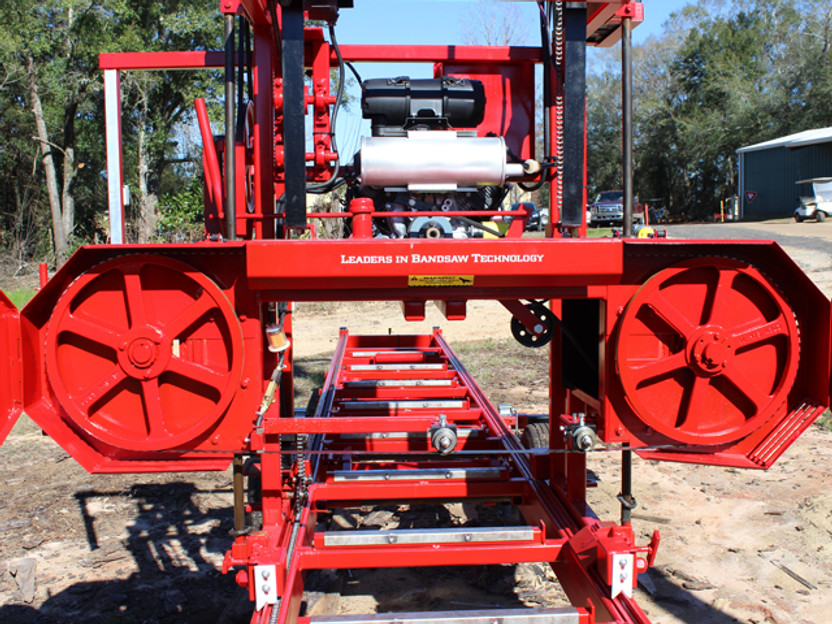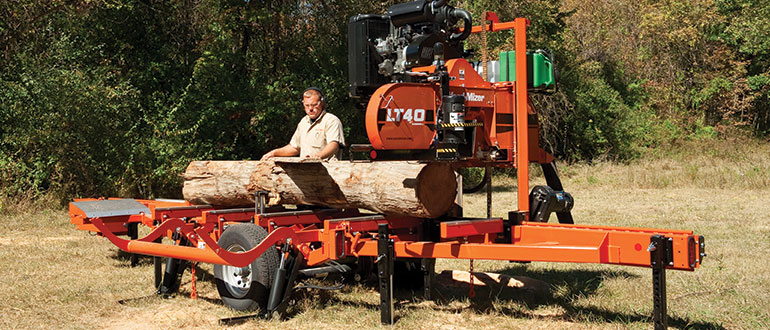How fast should a bandsaw mill run? If you’re curious about finding the optimal speed for your bandsaw mill, you’ve come to the right place. In this article, we’ll uncover the perfect pace for your mill, ensuring smooth and efficient operations. So, let’s dive in and get your mill running at just the right speed!
Now, you might be wondering why speed matters when it comes to bandsaw milling. Well, the speed at which your mill operates can profoundly impact the quality of your cuts and the overall productivity of your milling process. So, finding the sweet spot is crucial for achieving the best results possible.
But don’t worry, we’re here to guide you through it all. Whether you’re a beginner or an experienced mill operator, we’ll break down the factors that influence the ideal speed for your bandsaw mill. So, let’s get started and unlock the secrets to running your mill at the perfect pace for optimal performance.

How Fast Should a Bandsaw Mill Run: Unleashing the Optimal Speed
Welcome to the comprehensive guide on determining the ideal speed for a bandsaw mill. If you’re a woodworking enthusiast or a professional in the timber industry, understanding the optimal speed at which a bandsaw mill should operate is crucial. In this article, we will explore the factors that influence the speed of a bandsaw mill and provide insights into finding the perfect balance for maximum efficiency and quality output. Whether you’re a beginner or an experienced mill operator, this guide will equip you with the knowledge to ensure your bandsaw mill runs at its best.
The Importance of Optimal Speed
When operating a bandsaw mill, the speed at which the blade moves plays a vital role in achieving accurate cuts and maintaining the longevity of the equipment. Running a bandsaw mill at the right speed is essential as it directly impacts the cutting performance, the quality of the finished lumber, and the overall efficiency of the milling process. Both a slow and fast blade speed can have adverse effects on the final product.
Operating a bandsaw mill at a slower speed can lead to burning or charring of the wood, causing discoloration and affecting its structural integrity. On the other hand, speeding up the blade excessively can lead to premature wearing of the blade, resulting in frequent replacements and increased maintenance costs. Finding the optimal speed ensures clean cuts, minimal waste, and maximizes the overall productivity of the mill.
Determining the Ideal Speed
Several factors influence the ideal speed at which a bandsaw mill should run. Let’s dive into the key considerations:
1. Blade Type and Size
The blade type and size directly impact the recommended speed range. Different blades are designed for varying applications, such as resawing, cutting green wood, or hardwoods. Thicker blades with a larger number of teeth per inch (TPI) require slower speeds, while thinner blades with fewer TPI can handle higher speeds.
2. Wood Species and Moisture Content
The type of wood being milled and its moisture content determine the speed at which the bandsaw mill should operate. Softer woods, such as pine or cedar, can be cut at higher speeds compared to dense hardwoods like oak or hickory. Additionally, green or wet wood requires slower speeds to prevent excessive blade gullets from clogging.
3. Blade Sharpness
A sharp blade is essential for optimal performance. Dull blades increase resistance, requiring slower speeds to compensate, which can result in a reduced milling efficiency. Regular blade maintenance, including sharpening or replacing blades when necessary, will ensure the mill runs smoothly at the recommended speed range.
4. Feed Rate
The feed rate refers to how quickly the material is fed into the mill. It is vital to match the feed rate with the blade speed to prevent blade drift or deflection, ultimately affecting the accuracy and quality of the cuts. Investing in a bandsaw mill with adjustable feed rates allows operators to find the right balance for smooth and precise cutting.
Optimizing Blade Speed for the Best Results
Now that we understand the factors affecting the ideal speed for a bandsaw mill’s operation, let’s explore some tips for optimizing blade speed:
1. Experiment with Speed Ranges
Beginners should start by experimenting with the recommended speed ranges provided by the mill’s manufacturer. Test various speeds for different wood species and thicknesses to find the sweet spot that yields clean cuts without compromising efficiency or blade life.
2. Monitor Blade Performance
Regularly inspect the blade for signs of excessive wearing, burning, or deflection. These indicators may suggest the need for adjustments in speed or other factors affecting the milling process. Stay proactive in maintaining blade sharpness and make any necessary changes promptly.
3. Consider Blade Lubrication
Using appropriate blade lubrication can reduce friction and heat buildup, enhancing the overall cutting performance. Lubricants such as cutting oils or wax sticks can be applied to the blade to facilitate smoother cuts, reduce blade wear, and minimize the chances of burning the wood.
Key Takeaways
Operating a bandsaw mill at the right speed is vital for achieving optimal cutting performance, ensuring the longevity of the equipment, and maximizing productivity. Understanding the factors influencing the ideal speed, such as blade type and size, wood species and moisture content, blade sharpness, and feed rate, allows operators to fine-tune their milling process for the best results. By experimenting with speed ranges, monitoring blade performance, and considering blade lubrication, you can enjoy clean cuts, minimize waste, and get the most out of your bandsaw mill.
Key Takeaways: How Fast Should a Bandsaw Mill Run?
In simple terms, a bandsaw mill should ideally run at a speed that allows for efficient cutting without putting unnecessary strain on the saw blade.
- 1. Understanding the blade speed: The optimal speed for a bandsaw mill blade depends on its width and the material being cut.
- 2. Consider the blade’s tooth pattern and set: Blade speed should also align with the blade’s tooth pattern and set to ensure smooth cutting.
- 3. Balancing speed and feed rate: Increasing the mill’s speed may require adjusting the feed rate to maintain a consistent cutting experience.
- 4. Blade tension: Proper tensioning of the blade is crucial to maintain stability and prevent damage during operation.
- 5. Safety precautions: Always prioritize safety by wearing appropriate protective gear and adhering to manufacturer guidelines for speed settings.
Frequently Asked Questions
Are you curious about how fast a bandsaw mill should run? Look no further! Below are five common questions and answers related to the speed of a bandsaw mill.
1. What factors determine the ideal speed for a bandsaw mill?
The ideal speed for a bandsaw mill is influenced by several factors. First, consider the type and size of the wood you’ll be cutting. Hardwood typically requires a slower speed than softwood. Next, take into account the blade you’re using and its specifications. Different blades have different tooth configurations and require specific speeds to operate optimally. Finally, factor in the moisture content and density of the wood. Higher moisture content and density call for a slower cutting speed to prevent blade damage.
Ultimately, finding the ideal speed involves experimentation and observation. Start with the manufacturer’s guidelines, but be prepared to adjust based on the specific characteristics of the wood you’re working with.
2. What happens if a bandsaw mill is operated at too high a speed?
Operating a bandsaw mill at excessively high speeds can lead to several issues. First, it can cause unnecessary wear and tear on the blade, shortening its lifespan and requiring more frequent replacements. Additionally, running the mill too fast can result in a rougher cut, with more tear-out and a higher chance of wood damage. This is especially true when working with hardwoods or thicker lumber. Finally, high speeds can generate excessive heat, which can lead to blade warping or even combustion if the blade gets too hot.
To avoid these issues, it’s important to follow the recommended speed guidelines provided by the mill and blade manufacturers. If you notice any signs of overheating, poor cut quality, or premature blade wear, it’s crucial to reduce the speed to a more suitable level.
3. Can a bandsaw mill be run too slowly?
While running a bandsaw mill too slowly isn’t as detrimental as running it too fast, it can still have negative consequences. Slower speeds can cause the blade to become dull more quickly, leading to decreased cutting efficiency and a rougher finish. Additionally, if you’re working with harder and denser woods, a low cutting speed can increase the risk of the blade getting stuck or binding, creating dangerous situations.
It’s essential to find the right balance when it comes to speed. If you’re experiencing issues with sluggish cutting, poor finish quality, or frequent blade dulling, it may be a sign that you need to increase the speed of your bandsaw mill.
4. How can I determine the speed at which my bandsaw mill is currently running?
Determining the speed at which your bandsaw mill is operating can be done in a few different ways. Some bandsaw mills come with built-in speed indicators, either displayed on the control panel or provided as a separate gauge. If your mill doesn’t have this feature, you can use an affordable laser tachometer to measure blade speed. Simply position the tachometer near the blade, and it will provide an accurate reading of the revolution per minute (RPM).
Another method is to calculate the blade speed manually. Measure the diameter of the saw’s drive wheel and multiply it by 3.14 (pi) to find the wheel’s circumference. Then, multiply the circumference by the number of revolutions made by the wheel in one minute. This will give you the blade speed in inches per minute (IPM).
5. How often should I adjust the speed of my bandsaw mill?
Adjusting the speed of a bandsaw mill depends on various factors, including the type of wood, blade specifications, and cutting conditions. As a general rule, it’s a good idea to start with the recommended speed provided by the mill and blade manufacturers. However, it’s essential to monitor the cutting process continuously and make adjustments as necessary.
If you notice excessive heat, blade wandering, or poor cut quality, it’s a clear indication that you should make adjustments to the speed. Remember, finding the sweet spot may require some trial and error, so be patient and take the time to fine-tune the speed until you achieve the desired results.

Summary
So, how fast should a bandsaw mill run? Well, it depends on a few factors. Firstly, the type of wood being cut plays a role in determining the appropriate speed. Hardwoods generally require a slower speed, while softwoods can be cut faster. Additionally, the size and condition of the bandsaw blade are important considerations. If the blade is dull or damaged, running the mill too fast can cause excessive wear or even break the blade. Lastly, the operator’s experience and comfort level with the mill also impact the speed at which it should be run. It’s important to find a speed that allows for efficient cutting without sacrificing safety.
Ultimately, finding the right speed for a bandsaw mill is a balancing act that takes into account the type of wood, the condition of the blade, and the operator’s skill level. By considering these factors, a suitable speed can be determined that ensures both effective cutting and safe operation. So, the next time you’re using a bandsaw mill, remember to find that sweet spot of speed, and happy cutting!
